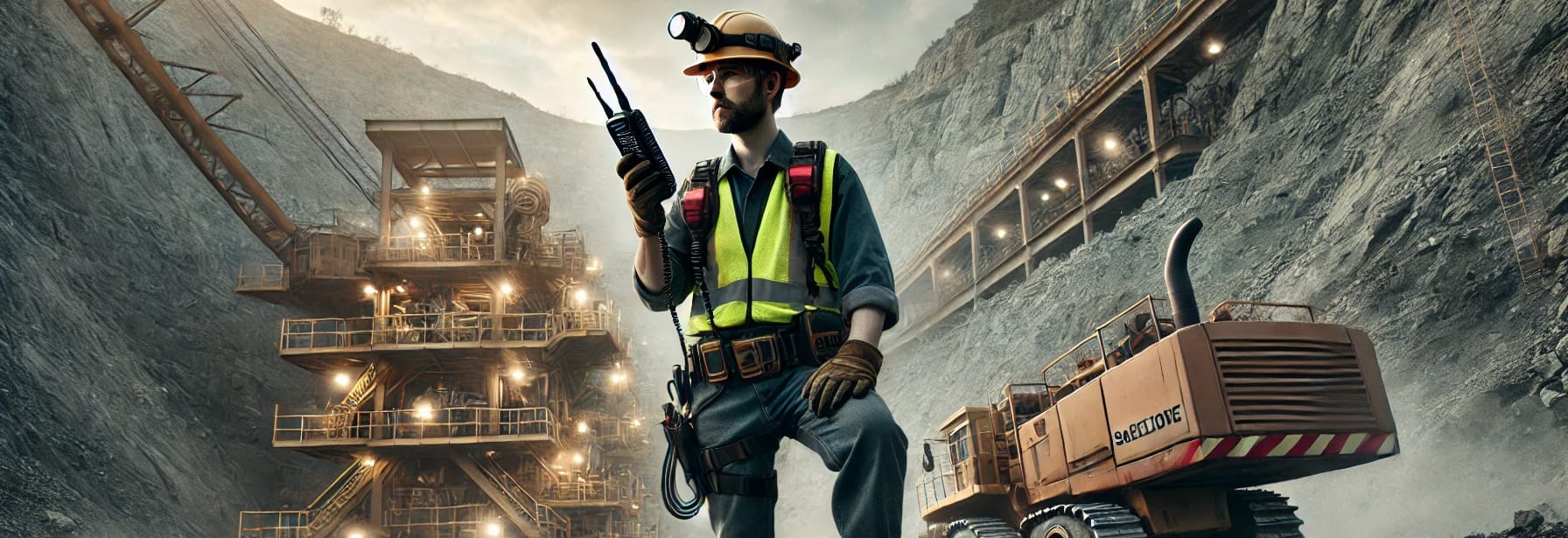Satellite networks have ushered in a new era of connectivity and efficiency for the industrial sector, fundamentally changing how operations are conducted, monitored, and optimized.
In industries as diverse as mining, oil and gas, agriculture, and construction, satellite technology ensures continuous, reliable communication and data sharing, even in the most remote and inaccessible regions. This global reach enables precise asset tracking, real-time environmental monitoring, and enhanced worker safety, all of which contribute to improved decision-making and operational efficiency.
By bridging the gap between remote industrial sites and centralized control centers, satellite networks play a pivotal role in driving productivity, sustainability, and growth in the industrial world, ensuring businesses can leverage the full potential of their operations regardless of geographical constraints.

Lone Worker
Satellite networks significantly impact the safety and efficiency of lone workers in the industrial sector, especially in remote or hazardous environments. These networks provide critical communication links and data services that ensure lone workers are not isolated, despite physical distances. Here’s how:
Explanation:
For industries operating in remote areas, such as mining, oil and gas, and forestry, the safety and productivity of lone workers are paramount. Satellite networks offer a reliable solution for maintaining constant communication, enabling real-time monitoring and emergency response capabilities.
Through satellite technology, lone workers can access navigation assistance, send SOS signals, and receive weather updates, reducing the risks associated with working alone. Moreover, satellite networks facilitate the transmission of operational data, allowing workers to report progress and receive instructions without the need for physical presence, thus maintaining efficiency.
This technology not only enhances worker safety by ensuring that help is always within reach but also supports operational continuity and data-driven decision-making in industries where traditional communication networks are unavailable.
How Lone Workers in the Industrial Industry are Affected by Satellite Networks:
- Enhanced Safety: Enables immediate communication with emergency services and support teams in case of accidents or health issues.
- Constant Connectivity: Provides reliable communication links for lone workers, reducing the risks associated with isolation.
- Real-time Monitoring: Allows companies to monitor the location and well-being of lone workers, enhancing safety protocols.
- Navigation Assistance: Offers GPS navigation services, helping workers navigate safely in remote areas.
- Weather and Environmental Alerts: Delivers real-time updates on hazardous weather conditions or environmental risks.
- Operational Efficiency: Supports the transmission of data and instructions, enabling lone workers to perform tasks with greater autonomy and efficiency.
- Emergency Response: Facilitates quick deployment of rescue and medical teams by transmitting precise location data in emergencies.
- Regulatory Compliance: Helps companies meet safety regulations by providing robust communication and monitoring solutions for lone workers.
- Worker Morale: Improves morale by ensuring workers feel connected and supported, even in remote locations.
- Data Transmission: Enables the remote submission of work reports and access to operational data, supporting informed decision-making.
Satellite networks thus play a crucial role in safeguarding lone workers in the industrial sector, providing essential services that enhance safety, operational efficiency, and communication. This technology ensures that despite the challenges of remote work, lone workers are supported, connected, and able to contribute effectively to their industries.

Construction
Satellite networks significantly influence the construction industry, enhancing project management, communication, and operational efficiency, especially in remote or challenging project sites. Here’s how:
Explanation:
In the construction industry, managing projects across vast distances and ensuring timely communication between site managers, workers, and headquarters can be challenging.
Satellite networks provide a reliable solution, offering global coverage that facilitates real-time data exchange, GPS navigation, and communication, regardless of location. This capability is crucial for coordinating logistics, monitoring site progress, and ensuring worker safety. Additionally, satellite imagery aids in site surveying and planning, offering detailed views of terrain and existing infrastructure, which is invaluable during the pre-construction phase.
Moreover, satellite technology enables the use of unmanned aerial vehicles (UAVs) for site inspection, progress tracking, and safety audits, further enhancing project oversight and efficiency.
How Construction is Affected by Satellite Networks:
- Real-time Communication: Ensures constant communication between site managers, workers, and headquarters, facilitating decision-making and coordination.
- Project Monitoring: Satellite imagery and UAVs supported by satellite navigation allow for detailed monitoring of project progress and site conditions.
- GPS Navigation and Mapping: Provides accurate positioning and mapping services, crucial for site surveying, planning, and logistics management.
- Data Transmission: Enables the fast and secure transmission of design documents, reports, and other essential project data between sites and offices.
- Remote Site Management: Supports effective management of construction projects in remote or inaccessible areas, ensuring operational continuity.
- Safety and Emergency Response: Facilitates quick response to emergencies by ensuring communication lines are always open and by enabling precise location tracking.
- Logistics and Supply Chain Management: Enhances the efficiency of material deliveries and equipment management through real-time tracking and coordination.
- Regulatory Compliance: Helps document project progress and compliance with safety standards and environmental regulations through detailed records and reports.
- Asset Management: Satellite tracking of construction assets, machinery, and equipment prevents loss and optimizes usage.
- Environmental Impact Assessments: Satellite imagery supports environmental assessments, helping to minimize the ecological footprint of construction projects.
Satellite networks thus play a critical role in modernizing the construction industry, providing tools and services that enhance project management, operational efficiency, and safety. By leveraging this technology, construction projects can achieve better outcomes, even in the most challenging environments.

Agribusiness
Satellite networks have revolutionized agribusiness by providing farmers and agricultural professionals with advanced tools for monitoring crop health, managing resources, and improving yields. These technologies facilitate precision agriculture, enabling more informed decision-making and efficient farm management. Here’s how:
Explanation:
Satellite networks offer high-resolution imagery and data crucial for understanding various aspects of agricultural operations. This includes soil moisture levels, crop health, and changes in field conditions, allowing for targeted interventions that conserve resources and maximize output.
By utilizing satellite-based GPS technology, agribusinesses can achieve precise planting, fertilizing, and irrigation, reducing waste and environmental impact. Furthermore, satellite data supports the monitoring of weather patterns and climate change effects, helping farmers adapt their practices to ensure sustainability.
This global connectivity also aids in supply chain management, from production to distribution, enhancing the overall efficiency of the agribusiness sector.
How Agribusiness is Affected by Satellite Networks:
- Precision Farming: Utilizes GPS and satellite imagery to implement precise farming techniques for planting, irrigation, and fertilization.
- Crop Monitoring: High-resolution satellite imagery allows for the monitoring of crop health, identifying issues like disease or pest infestation early on.
- Soil and Field Analysis: Satellite data provides insights into soil moisture and nutrients, enabling optimized crop management and land use.
- Weather Forecasting and Climate Analysis: Access to accurate weather data and climate change models helps farmers plan and adapt their agricultural practices.
- Resource Management: Satellite technology supports efficient use of water, fertilizers, and pesticides, contributing to sustainable farming practices.
- Yield Estimation: Satellite imagery aids in predicting crop yields, allowing for better planning and supply chain management.
- Irrigation Management: Remote sensing data from satellites assist in monitoring irrigation needs and scheduling, conserving water resources.
- Supply Chain Optimization: Enables real-time tracking of agricultural products from farm to market, improving the efficiency of the supply chain.
- Land Use Planning: Satellite imagery supports the assessment and planning of land use, aiding in conservation efforts and habitat protection.
- Disaster Monitoring and Response: Helps in assessing damage from natural disasters such as floods or droughts, facilitating quicker response and aid distribution.
Satellite networks thus significantly impact agribusiness, offering technologies that drive efficiency, sustainability, and productivity in agricultural operations. These advancements not only benefit farmers but also contribute to global food security and environmental conservation.

Mining
Satellite networks have a profound impact on the mining industry, enhancing exploration, operational efficiency, safety, and environmental monitoring. By leveraging satellite technology, mining operations can access a wealth of geospatial data, improving decision-making and operational outcomes. Here’s how:
Explanation:
Satellite networks provide detailed imagery and geospatial information crucial for identifying potential mining sites and assessing mineral deposits, significantly reducing the time and cost associated with exploration.
This technology also supports the monitoring of mining operations, enabling managers to oversee site activities remotely, track equipment, and ensure worker safety. Furthermore, satellite data is invaluable for environmental monitoring, allowing companies to assess the impact of mining activities on surrounding ecosystems and comply with regulatory requirements.
Real-time communication facilitated by satellite networks ensures that even the most remote mining sites remain connected, enhancing coordination, emergency response, and overall site management.
How Mining is Affected by Satellite Networks:
- Exploration and Site Identification: Satellite imagery helps identify potential mining sites and assess mineral deposits with high accuracy.
- Operational Monitoring: Enables remote monitoring of mining operations, including equipment tracking and workforce management.
- Environmental Impact Assessments: Satellite data supports the monitoring of environmental impacts, aiding in compliance with regulations and sustainable mining practices.
- Safety and Emergency Response: Facilitates real-time communication for safety management and quick response to emergencies or accidents.
- Asset Management: Provides precise tracking and monitoring of mining assets, optimizing usage and maintenance schedules.
- Supply Chain Management: Enhances the efficiency of the mining supply chain by ensuring seamless communication and logistics coordination.
- Terrain and Geospatial Analysis: Offers detailed terrain analysis and geospatial data for planning and executing mining operations.
- Weather Forecasting: Access to accurate and timely weather information helps in planning operations and mitigating weather-related risks.
- Communication: Ensures reliable communication links between remote mining sites, headquarters, and external partners.
- Regulatory Compliance Reporting: Supports compliance with environmental and safety regulations through accurate data reporting and analysis.
Satellite networks thus play a critical role in modernizing the mining industry, offering solutions that improve exploration accuracy, operational efficiency, and environmental stewardship. These advancements not only optimize mining operations but also contribute to the industry's sustainability and safety standards.

Autonomous Vehicles
Satellite networks significantly impact the deployment and operation of autonomous vehicles (AVs) within the industrial sector, enhancing their capabilities for navigation, communication, and environmental monitoring. These networks are pivotal in ensuring that AVs can perform a wide range of industrial tasks with high efficiency and reliability, even in remote or challenging environments. Here's how:
Explanation:
For AVs in industries such as mining, construction, and logistics, satellite networks provide the essential infrastructure for precise global positioning, real-time data transmission, and reliable communication with control centers.
This connectivity is crucial for the autonomous navigation of vehicles, allowing them to traverse complex industrial sites or navigate between locations safely. Satellite technology also enables the remote monitoring and management of these vehicles, facilitating the optimization of routes, schedules, and operational tasks. Furthermore, satellite networks support the integration of AVs into larger industrial systems, ensuring seamless coordination with other autonomous systems and IoT devices.
By leveraging satellite connectivity, industrial AVs can significantly increase operational efficiency, reduce human error, and contribute to safer working environments.
How Autonomous Vehicles in the Industrial Industry are Affected by Satellite Networks:
- Precise Navigation and Positioning: Enables AVs to navigate industrial sites and transport routes with high accuracy, essential for safety and efficiency.
- Real-Time Communication: Facilitates uninterrupted communication between AVs and control centers, allowing for real-time monitoring and operational adjustments.
- Data Transmission: Supports the rapid transmission of operational data and sensor information, enabling timely decision-making and system optimization.
- Remote Management: Allows for the remote control and management of AV fleets, optimizing their use and reducing downtime.
- Integration with Industrial Systems: Ensures AVs can seamlessly integrate with other autonomous systems, IoT devices, and industrial machinery for coordinated operations.
- Environmental Monitoring: Satellite networks enable AVs to collect and transmit environmental data, supporting sustainable practices and compliance with regulations.
- Safety Monitoring: Enhances the safety of industrial operations by enabling constant monitoring of AVs for potential hazards or malfunctions.
- Operational Flexibility: Provides the connectivity required for AVs to adapt to changing industrial tasks and environments, increasing operational flexibility.
- Supply Chain Optimization: Facilitates the use of AVs in logistics and supply chain management, improving the efficiency of material transport and delivery.
- Disaster Response: Enables AVs to operate in challenging conditions, including disaster response and recovery operations in remote or affected areas.
Satellite networks are essential for maximizing the potential of autonomous vehicles in the industrial sector, offering solutions that enhance navigation, ensure safety, and improve overall operational efficiency. This technology represents a key enabler for the future of industrial automation and smart operations.






Comments